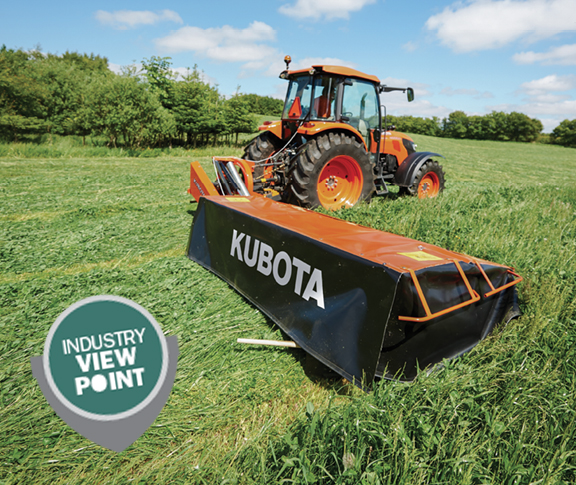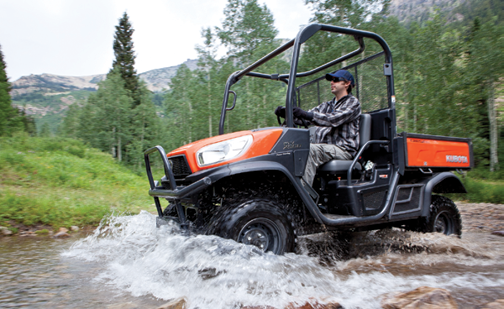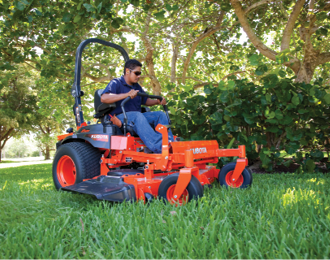
Kubota’s new line of hay tools is part of its entry into production agriculture. The first phase of implements will be available at Kubota dealerships early this year and will include disc mowers, rotary rakes and tedders.
Kubota helped define the rural lifestyle-sized tractor when it introduced its 21 horsepower tractor way back in 1969. Today, the company offers more than 80 tractor models in the 18-135 horsepower range. The company is now targeting production farmers and commercial landscapers with its new Kubota hay tools line and Z700 series of zero-turn mowers. On the horizon: tractors with higher horsepower to capture more of the production farming segment.
“Our dealers have been on the edge of the farm market. Some have been active, but have carried another line. We’re now beginning to equip our dealers to compete in this market with Kubota products,” says Greg Embury, senior vice president of marketing and dealer development.
Embury and Todd Stucke, vice president of the agriculture and turf division, share with Rural Lifestyle Dealer where Kubota is headed and how it plans to get there, including the introduction of new dealer support programs.
“The history of Kubota has been to earn dealer share more than market share…”
Capitalizing on Market Growth
Embury provides this overview of the rural lifestyle market: “The American dream is still 10 acres and a horse. Rural lifestylers are getting a little older, but we are seeing new people coming to the land. The recession slowed things down a bit, but there’s a sense that the economy is coming back. As we add innovative new products, we can gain market share and grow faster than the industry.”
Stucke adds, “We’re seeing the market as flat to slightly up and the positive news is that tractor sales are up 10% for all colors. As we grow the business into higher horsepower segments, we have to develop dealers who can sell those higher horsepower tractors. A way to do that is with the introduction of hay tools. A customer who comes in to buy a 120 or 130 horsepower tractor now has the hay tools to go with it.”

Greg Embury is Kubota’s senior vice president of marketing and dealer development.
Kubota introduced its hay tools series to its dealers at its national meeting last fall. The first phase of implements will be available at Kubota dealerships early this year and will include the DM series of disc mowers (working widths of 5 feet 6 inches up to 10 feet 5 inches); the RA series of rotary rakes (working width of 13 feet 9 inches) and the TE series of rotary tedders (working width of 17 feet 1 inch).
The hay implements will be produced by the Kverneland Group, which Kubota acquired in May 2012, including its factories in Norway, Denmark, Germany, France, the Netherlands, Italy, Russia and China.
Stucke says his priority is the integration of the hay tools within the Kubota dealer network. “This is a completely different product for us and a different segment. We need to be able to launch it correctly in terms of training, product support and dealer support. We want to make sure that we can create the same rewarding customer experience when buying a Kubota hay tool as when buying a Kubota tractor,” Stucke says.
Embury provides additional explanation about the entry into the market: “The history of Kubota’s product development has been evolutionary as we have entered new markets carefully and proceeded to expand our product line in those markets. Zero-turn mowers are a good example. Now, with our move into production ag, we are taking the same approach. Tractor size is steadily increasing and we have added a hay line in our recent phase one introduction. The world population is growing and must be fed, so the long-term outlook for production ag is positive as is the market for rural lifestyle products as the U.S. continues to recover from the great recession,” Embury says. “Kubota is committed to grow in both markets.”
Targeting Commercial Zero-Turn Mowers
Kubota first entered the residential zero-turn mower market in 2001 and has continued to expand its product line with the introduction of its consumer zero turn, the Kommander.
“The Kommander exceeded every one of our retail, market and performance goals,” Stucke says. “It’s a well-engineered product with a modern design. Bearing the quality Kubota name and backed by Kubota warranty and Kubota financing options, it has really been a hit with customers.”
For 2014, Kubota is leveraging the success of the Kommander by introducing its first dedicated commercial zero-turn mower.
“The Z700 introduced last October is our first commercial zero-turn model designed specifically to meet the rigorous demands of the commercial landscaper. With the Z700, the Kubota zero-turn lineup now includes 20 models of gasoline, diesel and propane powered units ranging from $4,900 to $16,900,” Embury says.
Building on UTV Segment
Kubota’s other big push for 2014 is its new RTV X-Series of work utility vehicles. These all new vehicles offer improvements in styling, ergonomics and durability. New styling elements feature a front-end design based on the look of pick-up trucks with front bumper guard and blue halogen tinted lights. New ergonomic features include tilt wheel, a new dashboard and adjustable seats. The RTV X1100C model also features a fully enclosed uni-body cab with standard heating and air conditioning. The X-series has Kubota-built diesel engines, 21.6 or 24.8 horsepower.

Kubota’s new RTV X-Series of work utility vehicles features improvements in styling, ergonomics and durability. Models have 21.6 or 24.8 horsepower Kubota-built diesel engines.
“Kubota takes pride in listening to its customers and dealers when it comes to product innovation,” Stucke says. Hundreds of customer surveys, dealer surveys and focus groups led to the features that are offered in the new series.
“When you have had the only air-conditioned cab on the market uncontested for more than 6 years, it’s a significant advantage. There are a couple of competitors sneaking up on us now with air-conditioned cabs, so we’re remaining vigilant,” Embury says.
“Like anything, you have to stay competitive. Kubota has a solid reputation for quality and durability, but we also need performance features for us to continue growing in the UTV market. We’re a work utility vehicle, but there’s the cross over segment to consider, too. In the future, we want to offer a larger array of products,” Stucke says.
“The UTV market is huge. The motorcycle guys build fast UTVs and guys like us build workhorses. We’re now meeting in the middle,” says Embury, referring to UTVs from power sports manufacturers.
Enhancing Dealer Support
Embury says several programs are in place or being developed to help dealers capture these new markets. For instance, Kubota will be doing more regional and national advertising, in addition to the local coop advertising dollars it provides dealers.

Todd Stucke is Kubota’s vice president of the agriculture and turf division.
“We will have more of a focus on marketing than in the past. When you market a great product, you get results,” Embury says.
They are also boosting dealer support — and asking more from dealers, too. The Kubota Univ. online training program was introduced last summer. Enhancements are planned through a partnership with the dealer business consulting firm Bob Clements International. The company has also hired a new dealer development director and training manager.
“Dealers have been asking for it and we’ve stepped up,” says Embury. “We are adding new online modules to the Kubota Univ. every month as we expand this training delivery site. Our recent partnership with Bob Clements International and the Southwestern Dealers Assn. has given us a great source of relevant content to help our dealers learn how to improve their operations and customer service.”
Kubota is also asking something of its dealers in return, including pursuit of a dealer certification based on a set of best practices.
“The Kubota Premier Award of Excellence program was introduced at our national dealer meeting in Memphis, Tenn., this past October and will begin with the recognition of dealers for their results in 2013. We will measure dealers on the elements of best business practices that focus on the most important things a dealer can do to support their customers and be successful.”

Meeting those standards will help dealers cope with competition from big box stores, Stucke says. “It all goes back to customer demand. The customer is going to the big box store for a reason and that’s because they sell at a lower price point. But if you look at that price point and add the Kubota name, warranty and financing, our dealers can get a premium over box store pricing,” he says.
Embury adds that capturing box store customers means capturing a new customer segment.
“We’re marketing the Kubota name to get more first-time buyers to know about us. In our experience, once a customer tries Kubota, they’re hooked,” Embury says.
Promise to Dealers
Embury says the Kubota dealer network has remained stable. “Our network hasn’t changed much in the last 20 years. We have 1,100 dealers in all 50 states. We do have fewer owners now, but the number of locations hasn’t changed much in 20 years. As we move into farming, we may need more dealers in the ag areas.”

Kubota’s Z700 is the company’s first dedicated zero-turn mower offering for the commercial landscape market. It follows the introduction in 2012 of the Kommander, its first consumer zero turn.
One direction they aren’t headed is toward selling in box stores. “We’re committed to the independent dealer network,” Embury says. Part of that commitment is allowing dealers flexibility in which lines they carry and how their stores look.
“The history of Kubota has been to earn dealer share more than market share. There was a time when many of our dealers had other lines. As we expand our products, we’ll gain more dealer share from those who prefer selling our products.
“We don’t prohibit dealers from carrying other lines. The dealer is our customer. We want to earn more of their business. If it results in them dropping a competitive line, that’s success in my opinion,” Embury says.






Post a comment
Report Abusive Comment